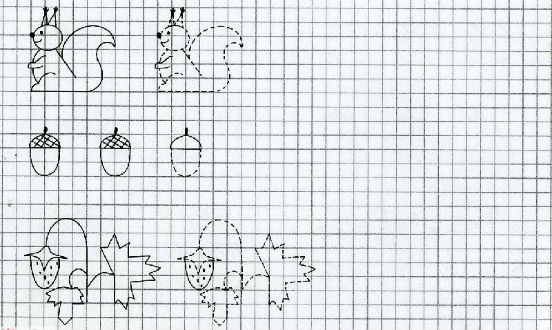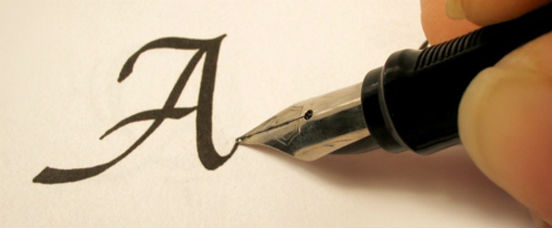Beautiful handwriting is an optional, but very useful skill. Clear spelling of words by schoolchildren helps teachers and parents understand words well, and the student himself can better navigate his notes and remember grammatical rules. Today we will learn what factors influence the formation of handwriting, and consider several exercises and tips for developing beautiful writing.
Handwriting formation
Forming handwriting is a rather lengthy process. It begins in preschool age (when the child first picks up a pen/pencil and tries to draw something) and ends at the age of 20-25 years. The process of forming and consolidating handwriting is influenced by:
- Anatomical and physiological characteristics of the child. What hand does he write with (right, left, both), how does he hold the pen when writing, what size are his palms and fingers, what is his usual posture when writing texts, etc.
- Temperament type. It influences character, perseverance, and the ability to work long and hard, which in turn shape one or another handwriting. For example, choleric children are in constant motion, are not able to perform monotonous work for a long time, and are fast. Therefore, the handwriting of such children is very often illegible, the letters are uneven, “jumping”, and have different sizes. Phlegmatic people, on the contrary, have written words and lines that are even, clear, often small, but identical and very neat. This is explained by their calm nature, ability to slowly and thoroughly carry out any work, and to engage in one type of activity for a long time.
- Quality and quantity of writing practice. The more often a child writes and tries at the same time, the clearer and more beautiful his handwriting will be. The quality of writing practice refers to the correct posture when writing, the convenient placement of a sheet of paper on a plane, and the student’s perseverance.
The influence of these factors is decisive, but quite amenable to correction. Special exercises and simple tricks will help your child develop perfect handwriting or correct writing deficiencies in older schoolchildren and adults.
Tips and exercises for beautiful handwriting
The sooner serious handwriting training begins, the clearer and more beautiful it will be. With age, it is more difficult to straighten a letter, but it is quite possible if you have a great desire and spare no effort.
The main thing is desire

The desire to have calligraphic handwriting is a great motivation for starting exercises and training. But children very often do not strive to write clearly and beautifully, and some do not even understand why this is necessary, because we live in the age of computer technology. In these cases, you can motivate the child in one of the following ways:
- Talk about the importance of clear handwriting. Neat and beautiful letter allows you to better understand what is written both by the student himself and by strangers, develops creative abilities, and can bring additional benefits to the student (for example, the child will be asked to sign posters, wall newspapers, etc.).
- Introduce a reward system. You can attract a child to cooperate in working on handwriting by promising him the purchase of a desired item for successfully completing tasks, relieving him of some of his responsibilities around the house, etc.
- Play on the child's pride. If a student likes to be the first in everything and strives for success in different areas, then you can show him that beautiful handwriting inspires admiration from other people, is a role model, etc.
Developing fine motor skills
good fine motor skills hands allows you to more confidently handle writing instruments, which helps straighten your handwriting. The following will help you develop this skill:
- Exercises with plastic materials. This is plasticine, clay, salt dough etc. It is enough to sculpt some figures several times a week, gradually complicating the task and adding small details.

- Beading, beading. For children preschool age You can give special educational toys in which you need to move small balls from one place to another. Older children can be occupied with needlework: creating beads and bracelets, weaving various figures and beaded jewelry, and bead embroidery.
- Folding buttons of different diameters. It is important that the exercise is performed with both hands at the same time.
- Connecting the dots. This seemingly simple exercise allows you to develop coordination of movements, establish eye-hand contact, and teach you to perform precise actions on paper. You can use ready-made dotted/dotted lines from children's books or create an outline for connecting yourself.
- Massage of fingers. You can do it yourself: carefully knead each finger with your second hand.
Copybooks
This is an ideal option for practicing beautiful handwriting for children of any age and even adults. Regular and diligent writing of letters according to a model helps to consolidate the skill of writing in a certain way.
IMPORTANT! Entries in the copybooks must be checked. If the child deviates significantly from the given model, it is necessary to correct the inaccuracies, show how to write correctly, and guide the hand. The explanation can be verbal or accompanied by a demonstration. correct spelling symbol, leading a child's hand with an adult's hand.
Drawing (copying)
Another great way to straighten your handwriting is to draw (copy) various symbols and images. To begin with, the child is given simple examples (for example, redraw geometric figure on square paper), then the task becomes more complicated (an unlined sheet is given, details are added to the image, etc.).

We print each letter
To practice handwriting, diligence and perseverance are important. The child needs to carefully write out each character, trying to bring its spelling as close as possible to the exemplary one. Video tutorials will help with this, showing in detail how to write a particular letter (you can use the alphabet of absolutely any language). First, the student simply reviews how to write. Then it performs actions in conjunction with the video. And finally, it outputs the characters from memory.
You can set the time for writing each type of letter in seconds (for example, 5-6 seconds). The child should not spend less than the specified time on performing the action. This will ensure the necessary accuracy and thoroughness.
Choosing convenient writing instruments
Surely you have noticed that the beauty and clarity of handwriting depends on the type of pen or pencil we write with. This is why it is important to choose comfortable writing utensils: try pens with different types pastes, with different thicknesses of the rod and body. Pen/pencil size and paper type are also important factors. The latter should not be too thin or too transparent (the characters written on the previous page are visible).
Choosing a comfortable position
It is very important that the student practices his handwriting in the correct posture. The back is straight, the writing hand rests completely on the table (it is unacceptable for the elbow to hang down). Exercises must be performed strictly on a hard surface. The remaining nuances of the pose (head tilt, torso rotation, position of the legs, etc.) are selected by the student himself, depending on what is most comfortable for him.
A few secrets of beautiful handwriting
Sometimes it is enough to correct minor points so that the handwriting becomes clear, beautiful, and understandable. There are some tricks for this:
- Try to write letters straight, without slanting. Capital letters are not always more beautiful than printed ones, and incorrect connections often spoil the whole picture. Writing characters without slanting will visually make your handwriting look businesslike, clear and compact.
- All letters must be the same size. Only capital letter has differences, the rest should have the same height and similar width. For practice, you can draw a sheet of paper into thin stripes and write letters within one line, limited at the top and bottom.
- There should be sufficient space between words. Do not make the space too short - this may cause the words to merge into one continuous text. To begin with, you can make a distance equal to the tip of the pen/pencil, simply substituting it to the last letter of the word. Next, the required space will be inserted automatically.
- Try to use as few abbreviations as possible. This is especially true for texts that will be read by other people. Abbreviations visually make words and sentences chopped off and may simply be incomprehensible.
More practice!

And finally, last but not least important advice- provide your child with the maximum practical exercises. You support his desire to improve his handwriting in every possible way, praise him for his successes and do not criticize him if something doesn’t work out. Let there always be copybooks, a large amount of paper and writing materials of various types in the house.
You can turn handwriting exercises into a fun game or competition. More often ask the student to write letters, shopping lists, sign postcards, etc. If it is possible to write something by hand rather than type it on a computer, then be sure to insist on the first option.
Smooth, clear and beautiful handwriting is a source of pride for a schoolchild. It greatly facilitates the understanding of the written text, promotes the development creativity And better memorization grammars. In many ways, the type of handwriting is determined by the natural characteristics of a person, but with great desire and perseverance, you can develop ideal writing at any age.
Wise owl 07 August 2015
Why might you need beautiful handwriting? Maybe at work you need to write beautifully and legibly. Well, for example, writing letters for business executives. Or sign greeting cards for various holidays. Engineers may also need beautiful, neat handwriting to fill out drawings and technical documentation. In this case, the filling rules themselves require the use of a specific font. There can be many reasons, up to a simple aesthetic desire to write beautifully, and not scribble in any situation.
To the question of how to develop beautiful handwriting, the answer is clear: you need to work on improving it. Painstakingly, diligently, for a long time. First of all, you need to write and write, and practice a lot. At the same time, not chaotically, but according to certain examples. You will need a thick notebook and a pen with spare refills. It is best to take the notebook into the cage. This will help you write smoothly and identical letters. It is also advisable to get examples of different fonts for clarity.
You need to start by writing each letter separately, several times. One letter must fit in one cell. You can try different fonts. After trying different fonts, you can choose the one you like best or which will work better. After practicing with individual letters, you should take any book, fiction or scientific, and start rewriting the text from it in a new handwriting. If there are professional texts to write down, that’s even better. In this case, you will be training your handwriting and doing your work at the same time. You should try to write evenly, square to square, carefully connecting the letters together.
At first it can be a bit difficult: the hand and fingers may get tired, the letters may not turn out as desired, the text will float along the lines. We need to try, keep working. This is how you can correct ugly handwriting and develop a new one.
Good option developing beautiful handwriting can be done using a drawing font. After adaptation to a specific hand, such handwriting becomes neat and beautiful. To do this, you need to take some kind of drawing; in the header of the drawing there are signatures and various text notes. First, individual letters are trained, and then words and sentences. In a drawing font, the letters are usually not connected to each other. But in handwritten text they need to be combined. That's why it will work original version handwriting, but at the same time maintaining the beauty of the letters and the accuracy of the writing.
If it is not an adult who needs to develop beautiful handwriting, but a child, then everything is a little simpler. Essentially, the same thing happens. The child learns to write letters, then connects letters into syllables, syllables into words, and so on. Parents or educators need to ensure that the child tries to write smoothly and correctly. There should be no shirking or negligence. Because the foundations are being laid now. Further, the handwriting will remain the same as it was developed from the very beginning. After all, changing your handwriting will be more difficult than making it beautiful in the first place. Developing beautiful handwriting is not technically difficult. All you need is samples and persistent practice.
What does handwriting mean when almost everything is now typed on a computer? Compiling documents and letters, blogging and most of the work is done using the keyboard. Sometimes printed text completely eliminates the use of pen and paper, which typically worsens handwriting. Hands simply lose the habit of writing, handwriting becomes uneven and difficult to read, and this state of affairs often causes psychological discomfort. Some people completely refuse to write by hand, while others are trying to correct the situation and are wondering “how to develop beautiful handwriting.”
Perhaps, as in any business that requires the creation of a habit, it is possible to develop beautiful handwriting only with regular training. No matter how much you would like to speed up this process, developing handwriting takes a lot of time and effort. But for those whose handwriting is a sore subject, the result should be worth all the effort.
To begin with, remember how in school years you learned to write capital letters. Remember this notebook with oblique lines for correct tilt letters? In order to improve your handwriting you will have to remember all the principles primary school– straight back, lined on a sheet of paper and sufficient lighting. So, you will need:
- Equipped workplace with a comfortable chair and a free writing surface
- Lined sheet of paper or special notebook for copybooks
- Blank A4 sheets
- Ballpoint and fountain pen
- Will, perseverance and patience
- Look at font catalogs online and print out the alphabets of the ones you like best. They will serve as a guide for you to create your own unique handwriting. You should not immediately choose elaborate fonts with a lot of monograms and small details - do not forget that your handwriting will always be with you, and should adequately correlate with situations when you have to write by hand.
- Keep your back and head straight and the sheet at a slight angle. Do not strain your hand or increase the pressure - this is of no use to you now. Practice writing with a fountain pen - it reacts sensitively to any change in pressure, and it will be easier for you to track the places where you “overpress” and make mistakes.
- Practice writing by repeatedly copying letters, and when you begin to get more or less even letters, “release” your hand. Feel the rhythm of the movements and the shapes of the resulting letters: all the turns, roundness, sharp corners and combinations. Perhaps you will experience delight - smoothly “flowing” words are comparable to a wave that carries meaning, and therefore becomes even more majestic and beautiful.
- Take your time. Handwriting needs time to “settle.” Write slowly and carefully, and speed will come with time. Make sure that the letters do not change their inclination - as you remember, the main thing is to develop a habit, and until then it is important to track the slightest movements of the hand.
- Once the letters become straight and your own writing style emerges, start practicing writing them with a ballpoint pen. It is more difficult to use, so at one time it was not approved for use among primary classes. But with the help of it you can train an even, identical pressure in all words.



